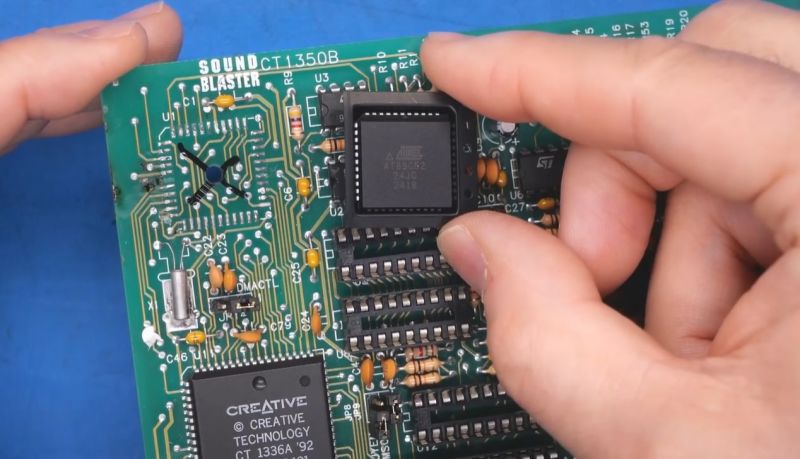What do you do when you find a ISA Sound Blaster 2.0 card in a pile of scrap? Try to repair the damage on it to give it a second shot at life, of course. This is what [Adrian Black] did with one hapless victim, with the card in question being mostly in good condition minus an IC that had been rather rudely removed. The core Creative CT1336A and Yamaha YM3812 ICs were still in place, so the task was to figure out what IC was missing, find a replacement and install it.
The CT1350 is the final revision of the original 8-bit ISA Sound Blaster card, with a number of upgrades that makes this actually quite a desirable soundcard. The CT1350B revision featured here on a card from 1994 was the last to retain compatibility with the C/MS chips featured on the original SB card. After consulting with [Alex] from the Bits und Bolts YT channel, it was found that not only is the missing IC merely an Intel 8051-based Atmel MCU, but replacements are readily available. After [Alex] sent him a few replacements with two versions of the firmware preflashed, all [Adrian] had to do was install one.
Before installation, [Adrian] tested the card to see whether the expected remaining functionality like the basic OPL2 soundchip worked, which was the case. Installing the new MCU got somewhat hairy as multiple damaged pads and traces were discovered, probably because the old chip was violently removed. Along the way of figuring out how important these damaged pads are, a reverse-engineered schematic of the card was discovered, which was super helpful.
Some awkward soldering later, the card’s Sound Blaster functionality sprung back to life, after nudging the volume dial on the card up from zero. Clearly the missing MCU was the only major issue with the card, along with the missing IO bracket, for which a replacement was printed after the video was recorded.
















i definitely uderstand the nostalgia factor of a bit of 1990s PC hardware, but it seems to me like it would’ve been easier to buy a soundblaster on ebay than to use one that’s already suffered a vicious attack :)
Doing things the easiest way will rarely get you featured on hackaday.
You ain’t from ’round here, are ya?
Another CT1350B then? :)
Because, there’s something special about the early 8-Bit Sound Blasters.
Their FM/DAC analog audio mixing balance was used by games such as GODS.
On later Sound Blasters, rivals (Thunderboard) or clones,
the ratio for audio volume was different so games didn’t sound correctly anymore.
Of course, with an SB16 or similar the software adjustable mixer would make it possible to restore this FM/DAC ratio.
More info: https://tinyurl.com/4swzubta
Another important or valuable thing is (was) the CT1350B card revision.
A few years ago, the CMS support via an reverse engineered GAL/PAL chip logic only worked with one revision.
On the other one, the AdLib chip could die if the replacement chip was installed.
Anyway, just saying. I suppose this issue has been solved meanwhile.
Modern programming for that GAL chip might work with either type.
But I’m not up-to-date, so please everyone check what I’ve said for installing an CMS upgrade.
It certainly would be easier to buy a working replacement. It would also be much more expensive and time consuming. The missing microcontroller on that card is cheap and readily available. Being able to do repairs like this are almost a requirement for vintage hardware enthusiasts, as most of the hardware needs some form of repair. Also, part of the fun of vintage hardware is repairing something that was bound for the scrap heap. The reverse engineered schematic referenced in the article was created by someone making a replacement PCB for one that had it’s gold edge connector cut off by scrappers.
I only skipped to the end to see if he had a new solution for running ISA cards.
Nope, old motherboard.
For an 8-Bit Sound Blaster or an AdLib card a very fast motherboard wouldn’t make much sense, though, I’m afraid.
The OPL2 chip used for FM synthesis needs a delay to work and older games had fewer delays in the program code.
That makes everything a bit timing sensitive, in short.
A fast 386 or slow 486 is the maximum that such an 8-Bit sound card can handle in practice, thus.
Unless it has a Turbo button or any other slowdown function, I mean.
Or if the old games are patched for more delays or if newer games with more delays are used.
But at this point, a more recent ISA sound card with an OPL3 chip can be used just as well, which works in faster PCs no problem.
The original Sound Blasters are really good for XT/AT/AT 386 class systems, I think.
(PS: Old games look for SB at IRQ7 rather than IRQ5)